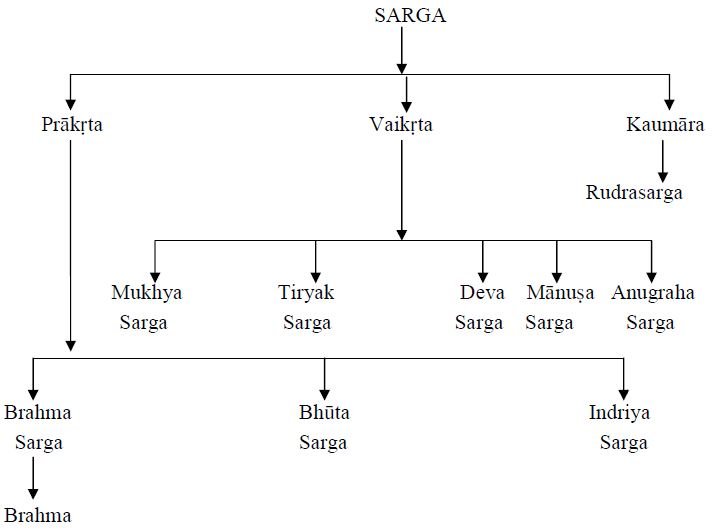The Markandeya Purana (Study)
by Chandamita Bhattacharya | 2021 | 67,501 words
This page relates ‘Worship and Mythology of Brahma’ of the study on the Markandeya Purana, one of the oldest of the eigtheen Mahapuranas preserving the history, civilisation, culture and traditions of ancient India. The Markandeyapurana commences with the questions raised by Rishi Jaimini (a pupil of Vyasa), who approaches the sage Markandeya with doubts related to the Mahabharata. This study examines various social topics such as the status of women, modes of worship, yoga, etc.
2. Worship and Mythology of Brahmā
In the vedic literature, Brahmā is acknowledged as the Supreme god who is not only trusted to be the creator god but also the preserver of the entire universe. Brahmā has a very distinguishable place among the gods mentioned in the ancient literature, viz. the Purāṇic literature, Brāhmaṇa literature etc. In the post-Vedic periods, Brahmā became more famous as Prajāpati and was worshipped as such.
In the Mārkaṇḍeyapurāṇa also Brahmā is found to be mentioned as Prajāpati[1] which signifies the protector of the creatures. According to the Śatapathabrāhmaṇa, the word Prajāpati means productiveness.[2] The Gopathabrāhmaṇa also explains the term prajāpati as the creator and the protector of the progeny.[3] The word prajāpati is also found in the Matsyapurāṇa and Kūrmapurāṇa.[4] The Vāyupurāṇa also explains the term as the protector of the creatures.[5] The word brahmā has been derived from the root ‘bṛṃḥ’, which means ‘to multiply’ or ‘to crease’.[6] It is used in both masculine and neuter gender, Brahmā is in masculine and Brahman is in neuter gender. Kālidāsa, in his Raghuvaṃśam, explains that Brahmā is the deity of brahma-saras, which is equivalent to avyakta sarovara of biddhi.[7]
In the 93rd chapter of Mārkaṇḍeyapurāṇa, there is a story of worship of Lord Brahmā.According to the story, sage Ruci worshipped lord Brahmā to fulfil his desire. The forefathers of Ruci told and advised him to marry a maiden. He wandered the whole world for a maiden. Failing to obtain a maiden he fell into deep thought. He then became greatly agitated in mind. Many questions came to his mind and he was doubtful about his duty which would affect his forefathers’ advancement. Finally Ruci decided to propitiate lotus born Brahmā with austerities. Thus, to gain his desire, Ruci performed austerities to lord Brahmā for a hundred celestial years. Lord Brahmā got pleased with his worship and told Ruci to declare his earnest desire.[8] Then Ruci told about the desire of his forefathers. After hearing his wish Brahmā spoke that he (Ruci) would be Prajāpati. He would create human folk. After that getting sons and performing ceremonies, he found a wife and performed worship to the pitṛ and these pitṛs bestowed on him the desire of wife and sons.[9]
Brahmā is generally identified as the great father of the world. He is the all in all in the world. Brahmā, is also called as Svyambhū[10] , Prajāpati[11] , Pitamaha[12] and Lokapitāmaha[13] .At first Brahmā was considered as the creator, the preserver and the destroyer, later on this function has been appropriated by the other gods. He is the only one to perform these three fold functions.[14] Brahmā manifested himself as Brahmā, Viṣṇ and Śiva performing the creating, preserving and destroying the world accordingly.[15]
According to Mārkaṇḍeyapurāṇa, Brahmā created the whole universe. He accomplishes the process of creation with the help of five elements viz. earth, air, water, ether and fire.[16] His supreme position is acknowledged and he is called the self existent god i.e. Svayambhū.[17] As a creator, He creates the whole universe (lokakṛt), and all that moves and does not move.[18] He is only called the lord of the universe. So he is called by various names which are related with the world created by him.
Some of such names are:
- Jagadyoni (42.27),
- Lokatantrin,
- Hiraṇyagarbha (42.29),
- Jagadādi (43.8),
- Jagatpati (43.9),
- Jagatpūrva (43.20),
- Jagatogatiḥ (93.7),
- Jagatsūtikara (98.10).
Brahmā is the cause, who itself is eternal. He is also call first male (Ādi-puruṣa) and unborn (Aja).[19] This purāṇa describes Brahmās own birth from the mundane egg or from the lotus so that he is call Svayambhū.[20] He is also known as Bhūpadmakarṇikāsaṃstha (43.21), Kamalodbhava (101.2), padmayoni (42.19), paṅkajajanman (47.97). Viṣṇu mentions about the birth of Brahmā out of his (viṣṇu’s) novel-lotus.[21] At that time when lord Viṣṇu, stretching seṣa out, wooed the sleep of contemplation at the end of the kalpa, two terrible demons i.e. Madhu and Kaitabha springing from the root of Viṣṇu’s ear and came to destroy Brahmā. Brahmā was saved by Viṣṇu from destruction at the hands of the demons.[22]
The Mārkaṇḍeyapurāṇa has described briefly on the birth of Brahmā in the chapter 43. This Purāṇa also shows the creation of world at the beginning, there were prakṛti and puruṣa and both of them were standstill. After that, parameśvara entered them and then the creation started by owing to vibration in prakṛti. As a result, there are three types of creation developed i.e. the prākṛta underwent three changes i.e. the Brahmasarga, the Bhūtasarga and the Indriyasarga. From the Brahmasarga, lord Brahma took his birth. The genealogy of Brahmā could be understood from the following table.

In the 16th chapter of this Purāṇa, we have found the birth of Brahmā in the incarnation of Soma, which has been already mentioned in the heading of Dattatreya’s birth.
Footnotes and references:
[1]:
yathā sasarja vai brahmā bhagavānādikṛtprajāḥ/
prajāpatiḥ patirdevastanme vistarato vada // Mārkaṇḍeyapurāṇa, 44.1
[2]:
prajananaṃ prajāpatiḥ / Śatapathabrāhmaṇa, 5.1.3.10
[3]:
tadyadabravīt prajāpate prajāḥ sṛṣṭā pālayasveti tasmāt prajāpatirabhavat tatprajāpateḥ prajāpatitvam / Gopathabrāhmaṇa, 1.1.4
[4]:
[6]:
bṛhattvādbṛṃhaṇatvācca bhāvānāṃ salilāśrayāt /
yasmādbṛṃhyate bhāvān brahmā tena nirucyate // Ibid. , 1.4.29
[8]:
Mārkaṇḍeyapurāṇa, 93.1-6
[9]:
Ibid., 93,8-10
[10]:
Ibid., 43.17
[11]:
Ibid., 44.1
[12]:
Ibid., 43.8
[13]:
Ibid., 47.40
[14]:
[15]:
Ibid., 43.13
[16]:
Ibid., 45.46
[17]:
[19]:
Ibid., 42.29
[20]:
viṣṇutve cāpyudāsīnastisro’vasthāḥ svayambhūvaḥ / Ibid., 43.17
[21]:
Ibid., 78.51
[22]:
Ibid., 78.48-50
